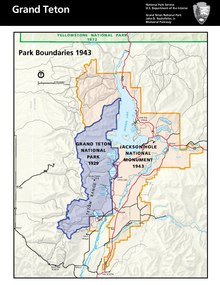
On March 15, 1943, Franklin D. Roosevelt signed Presidential Proclamation 2578 establishing a large swath of land east of the Teton National Park as a national monument.[1] The area of land covered 221,610 acres (89,680 ha). The majority of the land was National Forest, but 32,117 acres (12,997 ha) of the monument were donated by John D. Rockefeller, Jr., and 17,000 acres (6,900 ha) were privately owned ranches. This proclamation incited a controversy in Teton County that caused immediate pushback from western congressmen who saw the act as a violation of state sovereignty.[2][3]
- ^ Booklet of the Congressional hearing to abolish the Jackson Hole national Monument, 1A, Booklets, Burt Family Collection, 7570, American Heritage Center, University of Wyoming.
- ^ Box 1A, Burt Family Papers, 1911-1970, 07570, American Heritage Center, University of Wyoming
- ^ "America's National Monuments: The Politics of Preservation (Chapter 11)". www.nps.gov. Retrieved 2021-06-28.